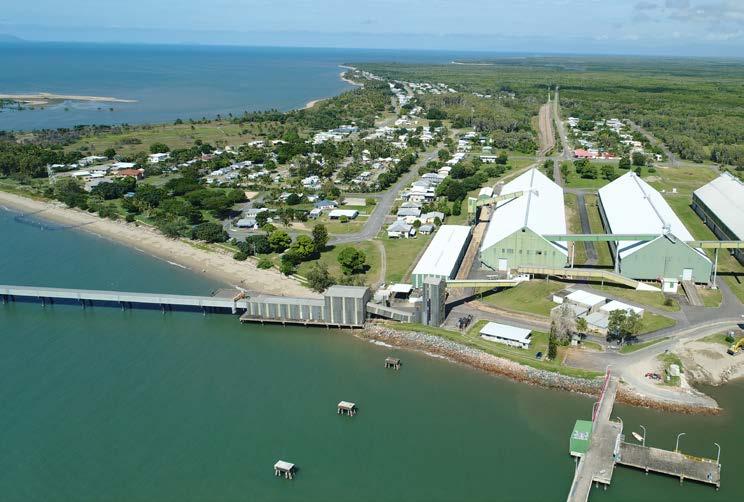
31 minute read
QSL report
QSL MARKET UPDATE
Current as of 28 September 2020.
Advertisement
Sugar Currency
Bearish sentiment dominated the first half of the month as the OCT20 contract dropped below 12 USc/lb, trading as low as 11.73 USc/lb. The prompt contract has since found some support leading into expiry trading as high as 13.06 USc/lb.
Speculative activity continued to increase in early September, reaching a 191,000 net-long position before a rapid sell-off down to a 144,000 net-long position at the time of writing.
Despite a healthy monsoon in Thailand, there appears to be little confidence that they will bounce back quickly from their recent crop failure and return to normal production levels next season.
Brazil: UNICA numbers indicated a solid recovery in ethanol sales, resulting in a slightly lower sugar/ethanol mix than previously anticipated. Export shipping lineups in Brazil are down to 19 days, invalidating previous doubts about whether they could get sugar out of their country. Estimates are creeping up towards 38 million metric tonnes raw sugar.
The likely extension of India’s export subsidy program continues to loom over the market.
ICE 11 trading range going forward: Broader trading range expected to be around 11.50 to 14.00 USc/lb.
KEY INDICATORS
28/09/2020
ICE11 Prompt (OCT20) 13.00 USc/lb Brazilian Real/$US exchange rate 5.56 BRL Brent Crude Oil $US41.92/barrel Ethanol/Raw Sugar Parity 10.15 USc/lb Net Spec Position 179,000 (net long)
Monthly change
+0.40 USc/lb +0.17 BRL -$US3.89 +0.55 USc/lb - Despite trading as high as 0.7414 against the US Dollar (USD) early in the month, the Aussie has reversed course rapidly over recent weeks posting a low of 0.7006 at time of writing. For the first time in recent months we have seen domestic issues impact our currency. Weaker-than-expected Australian GDP figures and the extension of the Victorian COVID-19 lockdown has weighed heavily on the economic outlook in recent trading sessions and the RBA has indicated that it may intervene further to loosen policy settings in response. Trade tensions between the US and China continue. Since the Australian Government called for an investigation into the origins of the coronavirus pandemic, China has announced the suspension of some Australian beef exports. The US election is far too close to call at this stage. Trump has said on several occasions that a close result may be contested. There is potential for renewed US Dollar and equities weakness should the outcome bring political uncertainty. AUD/USD trading range going forward: 0.7100 to 0.7500. Risks Ahead: Second wave of COVID-19 in Australia, US-China and Australia-China relationships and the next 2 months before the US Presidential election.
28/09/2020
$AUS/$US exchange rate $US0.70555 $US Index 94.64 Chinese Yen/$US exchange rate 6.82 CNY S+P 500 Index 3,298.46 RBA Overnight Cash Rate 0.25%
Monthly change
-$US0.0213 +2.2710 -0.0417 CNY -209.5500 -
RAW SUGAR PRICES $500 Per Tonne Actual $400 $420 $440 $460 $480 AUD $360 $380 $340 3-Jun-19 3-Jul-19 3-Aug-19 3-Sep-19 3-Oct-19 3-Nov-19 3-Dec-19 3-Jan-20 3-Feb-20 3-Mar-20 3-Apr-20 3-May-20 3-Jun-20 3-Jul-20 3-Aug-20 3-Sep-20
2020 Season 2021 Season 2022 Season 2023 Season
This is a whole-of-season ICE 11 price chart, based on the Target Price Contract’s current 5:1 pricing ratio for the 2020 Season and 1:2:2:1 pricing ratio for the 2021, 2022 and 2023 Seasons. Disclaimer: This report contains information of a general or summary nature and is based on information available to QSL from many sources. While all care is taken in the preparation of this report, the reliability, accuracy or completeness of the information provided in the document is not guaranteed. The update on marketing and pricing activity does not constitute financial, investment advice. You should seek your own financial advice and read the QSL Pricing Pool Terms, which are contained on QSL’s website. Nothing contained in this report should be relied upon as a representation as to future matters or that a particular outcome will be achieved. Information about past performance is not an indication of future performance. The information in the report is current as at the time of publication and is subject to change, as the information is based on many assumptions and is subject to uncertainties inherent in any market. QSL does not accept any responsibility to any person for the decisions and actions taken by that person with respect to any of the information contained in this report.
QSL GROWER PRICING UPDATE
Brazil
Australia
Your Trusted Partner
250 300 350 400 450
Grower Pricing QSL GROWER-MANAGED PRICING FILLS –
2020-Season sugar prices returned to levels 2020, 2021 & 2022 SEASONS above $400/tonne actual for Australian producers in late
September, sparking some grower pricing activity. Tonnes
At the time of writing, this rally had seen orders filled for 140,000 the 2020-Season QSL Target Price Contract ranging between $413.80 and $419.43/tonne actual. 120,000 2021-Season Target pricing at $400/tonne actual was 100,000 also secured.
The Oct20 position of the Target Price Contract 80,000 was rolled at a cost of $8.85/mt. The total roll adjustment is now a cost of $9.43/mt. 60,000
Key Deadline: October 31 is the last day for growers to nominate $500 40,000
QSL as their GEI Sugar marketer for the 2021 Season. $480
$460 20,000 FNQ MARKETING SESSIONS $440 0
$400 $420 Far North Queensland marketing sessions with Matt Page 6th-9th October. <$400 $410 $420 $430 $440 $450 $460 $470 $480 $490 2020 Season 2021 Season 2022 Season >$500 $360 $380 RSVP to Amanda Sheppard on 0418 264 393 or email amanda.sheppard@qsl.com.au This chart captures all pricing achieved as of 28.9.20 using QSL’s Target Price Contract, Individual $340 Futures Contract and Self-Managed Harvest products. Prices quoted at AUD//tonnes actual gross.
18-Jun-19 18-Jul-19 18-Aug-19 18-Sep-19 18-Oct-19 18-Nov-19 18-Dec-19 18-Jan-20 18-Feb-20 18-Mar-20 18-Apr-20
Far East Premium
The Far East Premium reflects the average difference in the freight cost of supplying raw sugar from Brazil to eastern markets as opposed to shipping from Australia or Thailand to eastern markets. Buyers in eastern markets, such as Japan, Korea and Indonesia, pay significantly higher sugar prices when sourcing from western suppliers at a greater geographical distance, such as Brazil, due to the increased freighting costs. In contrast, sellers in the eastern hemisphere, such as Australia or Thailand, have comparatively lower freighting costs and as such are able to increase their sugar prices to reflect this difference in freight rate. This is the geographical premium known as the Far East premium and represents the extra cost to bring sugar from the western hemisphere to the east. The value of this premium will fluctuate depending on the availability of sugar in the Far East and the Far West. If there is a significant surplus of sugar in the Far East, eastern sellers will have to compete to sell their sugar and may be required to lower their selling price. As a result, some of the far east premium is competed away. On the other hand, if there is a deficit of sugar in the Far West, buyers may be prepared to pay a premium for the certainty of delivery from the East.
COST OF DELIVERED SUGAR
Brazil
Australia
250 300 350 400 450
ICE11 Sugar Price Freight Cost Far East Premium
Current estimated returns in Australian Dollars as of 24 September 2020.

Sunsuper joins RideWest to raise funds for Flying Doctors
Daniel Kinnane, Sunsuper Regional Manager based in Mackay (pictured below) has been cycling for five years and has recently taken up the challenge of riding 1,237km in a charity cycle from 3 – 9 October to support the Royal Flying Doctor Service’s Wellbeing Out West program.
RideWest is a biennial charity bike ride from Brisbane to Longreach and this year celebrates its tenth anniversary with the ride taking place during Mental Health Month in October. Over the last 10 years, RideWest has raised over $1,000,000 to provide mental health services to Queenslanders living in remote regional areas and they’re looking to raise another $400,000 in 2020.
The Wellbeing Out West program helped over 7,500 Queenslanders last year, providing free counselling, education and support to people living and working in remote parts of western Queensland.
On Saturday 3 October, RideWest 2020 will be starting out from Amberley air base in Brisbane with 40 riders and cycling through to Longreach in just seven days.
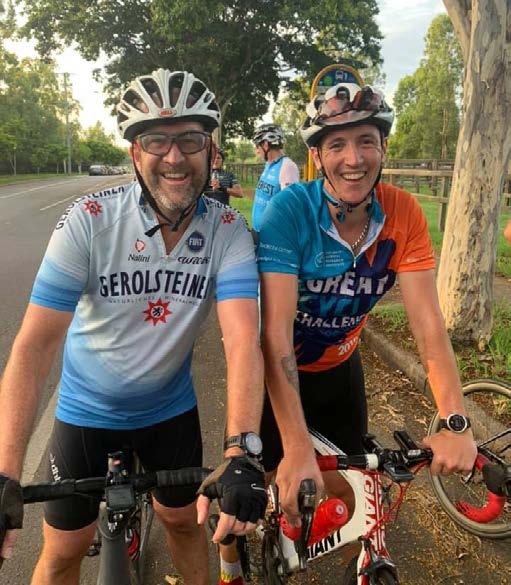
Sunsuper’s Dan Kinnane said he will be there every inch of the way. ‘As one of the familiar faces for Sunsuper in the regions, it’s an honour to represent our Fund at this event,” said Dan. ‘Aussies living in regional or remote areas don’t have easy access to the resources that we often take for granted. Through this charity, we can all do a little to help people living in remote areas that are quite often growing our food and putting the clothes on our back.” Sunsuper’s Head of Growth (QLD), Patrick Twomey, said Sunsuper was very proud to be a supporting partner of RideWest. “Sunsuper has always had a strong presence through rural and regional Queensland and this was further enhanced with the merger of AustSafe Super in April 2019,” said Patrick.
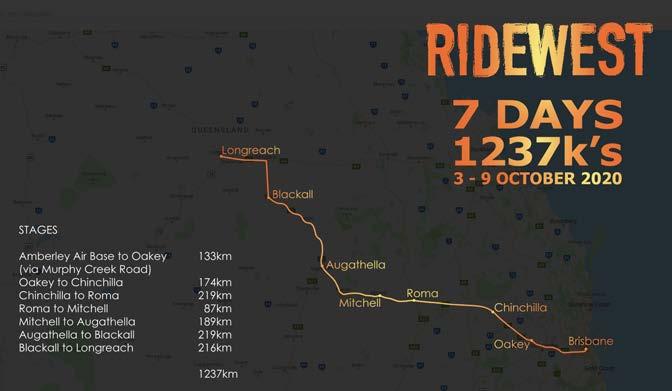
“To show our continued commitment, Sunsuper is proud to be a supporter of this year’s RideWest. We can see the great work that the Royal Flying Doctor Service achieves with the Wellbeing Out West mental health programs, year-in and yearout, assisting people in some of the most remote areas in the country.” For more information on RideWest and the Royal Flying Doctor Service Wellbeing Out West program, visit RideWest or Royal Flying Doctor Service.
Queensland’s sugarcane farmers are driven to GROW a prosperous and resilient FUTURE

QUEENSLAND NEEDS A GOVERNMENT THAT WILL REMOVE OBSTACLES
Reduce the cost of power and water to drive productivity and profitability
Electricity bills paid by farmers have risen 130% since 2006-07. Irrigators have been excluded from recent price reductions for small business and households. High water and electricity costs discourage irrigation and constrain productivity which affects regional economies, mill viability and international competitiveness. Current tariff structures deliver huge profits to energy companies and the Queensland Government.
Actions
→ Introduce a suite of agricultural electricity tariffs capped at 16c/kWh. → Write down Ergon’s regulatory asset base by 40%. → Allow retail competition in regional Queensland. → Remove solar feed in as a network charge. → Commit to lower bound irrigation water pricing.
3.
Remove roadblocks to disaster preparedness
Cane growers are resilient and productive in the face of natural disasters such as cyclones, floods and drought. However, insurance for the cane regions is becoming prohibitive and leaves growers vulnerable.
Actions
→ Remove Queensland Government stamp duty from insurance premiums. → Support the development of and underwrite affordable index-based disaster insurance. → Provide assistance for the development of individual risk management plans.
Cut red tape on farming which doesn’t help the Great Barrier Reef
The 2019 expansion of reef regulations is unnecessary and intrusive with no guarantee of water quality improvement. Related targets for industry are excessive and not evidence-based. CANEGROWERS analysis shows the current underlying intent of a 30% cut to nitrogen use will cost the state economy $1.3 billion over the next decade. Confidence needs to be restored in the scientific evidence used to justify policy.
Actions
→ Repeal 2019 reef legislation and regulations. → Make water quality plans and programs realistic and credible. → Overhaul the system that manages and scrutinises water quality research used to justify regulations.
CANEGROWERS Chairman Paul Schembri
TO UNLEASH OUR POTENTIAL....
Build a diversified industry for regional economic growth
Sugarcane growers produce around 30 million tonnes of a renewable resource every year.
Action
→ Support the development of electricity generation and manufacturing of bioproducts from renewable sugarcane.
Back our commitment to environmental responsibility
Our best management practice program Smartcane BMP is securing our international credentials to meet market demands for sustainable sugar.
Action
→ Commit resources and policy to continue the program’s work with growers.
Invest in a future agricultural workforce Actions
→ Fund agricultural education in schools to showcase a diversity of roles to students deciding on future careers. → Support post-school skills training and education including microcredentialing. → Fund expanded opportunities for industry-specific training and skills development.

7.
8.
Enable sustainable and innovative electricity and water use for increased productivity Actions
→ Reduce electricity and water prices to encourage greater use of irrigation water allocations and infrastructure to realise the full potential of these assets. → Implement new ways to share renewable electricity.
Local grids will enable growers to access energy generated by sugar mills and peer-to-peer trading will encourage generation investment on-farm. → Continue on-farm energy use efficiency programs and fund $20 million energy use efficiency improvements. → Examine and address challenges facing cane irrigation schemes.
Fund research and improve government services to agriculture Actions
→ Increase state funding for research, development and extension through SRA to $4 million per annum. → Link ongoing research funding to CPI and widen outcome expectations to include productivity, profitability and sustainability. → Restore the state’s capacity for managing the risk of pest and disease incursions. → Move functions related to agriculture from the
Department of Environment and Science to the
Department of Agriculture and restore a balance in the Queensland Government’s approach from a solely water quality-driven focus to a productivity and profitability focus with best management practice and continuous improvement at its core.
QUEENSLAND WILL HARVEST THE REWARDS OF A PROFITABLE AND PRODUCTIVE SUGARCANE INDUSTRY CANEGROWERS analysis shows that for every dollar generated by cane growing, $6.42 of economic activity is delivered to the Queensland economy. As we grow, so do the communities and industries around us.
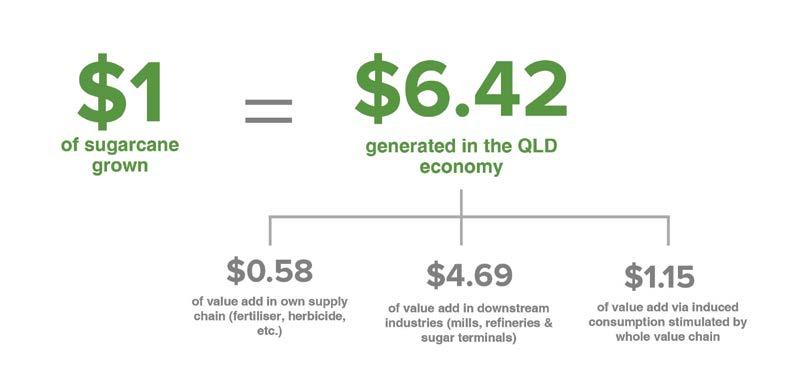
4,305 sugarcane farms in Queensland
21 mills operating in Queensland
30.5 million tonnes of sugarcane crushed annually in Queensland, producing 4.5 million tonnes of raw sugar
Total sugar supply value chain supports over 23,650 jobs in Queensland Total sugar supply chain supports approx. $4 billion in economic activity
Source: QEAS July 2019 The economic contribution of the Sugarcane industry to Queensland and its regional communities report.
CANEGROWERS has represented the interests of Queensland sugarcane farmers for over 90 years.
CANEGROWERS comprises 13 district companies with offices in all cane regions, staffed by dedicated and professional personnel. CANEGROWERS members are represented by 78 elected members, all sugarcane growers. A 21-person Policy Council provides overall direction while an 8-member Board provides corporate governance.
For more information, contact: Dan Galligan, CEO T: 07 3864 6444 M: 0429 707 809 E: dan_galligan@canegrowers.com.au
SILVAN’S INNOVATIVE SOLUTIONS FOR INTER ROW WEED CONTROL WITH SHIELDED OR SPIDER SPRAY HEADS
Silvan Australia has developed innovative solutions for intensive growing operations where there is a need to manage and control weed growth in the inter rows.
The applications are foremost in industries like sugarcane and strawberry production, although there is application potential in also any row crop growing situation in horticulture in particular. Silvan’s spraying specialist David Carr says that solutions have been created by building a fully galvanised multi -row hydraulic fold boom fitted with stainless steel spray lines which can be fitted with multiple Spider spray heads or fully shielded spray heads. Both these options ensure that the spray application is made direct to the surface growth limiting the risk of spray drift. The sprayer is typically configured as a four or six row unit with the shielded spray head option commonly being 90 cm in width although it is available in widths ranging from 50 to 130cm as required to suit the specific application. There are normally two twin swizzle nozzles per shielded spray head with air induction nozzles.
The Silvan spider head is a popular choice in the sugar cane industry for weed control early in the growing season. David Carr adds “Silvan has the unique ability to build spray application solutions that meet the exact needs of growers. We work with farmers and growers Australia-wide to build and supply

spraying solutions that exactly meet their growing practices and needs." For more information or technical advice call 1300 SILVAN (1300 745 826) or email info@silvanaust.com
Pictured: site specific solution with four or six spray heads can be created by Silvan for specific inter row spray applications to suit. individual grower needs.

4 & 6 ROW CONFIGURATIONS AVAILABLE
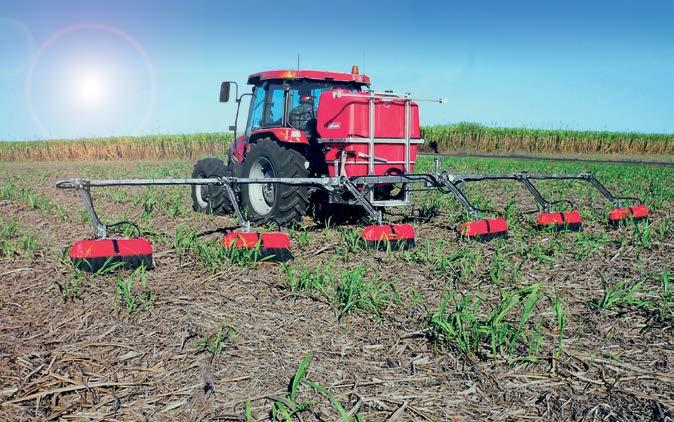
Now available with ‘Spider’ spray head
The Silvan Cane Boom is designed specifically for Australian cane growers. It incorporates choice of standard or shielded spray heads with air inducted nozzles to minimise spray drift. The fully galvanised 4 or 6 row boom comes standard with a hydraulic twin folding ram mechanism and adjustable tracking arms.
• Available with 600, 800 or 1100 Litre tank capacity • 50mm Camlock bottom fill and venturi chemical suction probe (1100 Litre only) • Choice of manual, electric or automatic rate control • Optional broadacre boom attachment • Optional hydraulic boom lift
Connect with us
Call 1300 SILVAN (745 826) or visit silvan.com.au for more information or to find your nearest dealer The Spraying Specialists

The Palaszczuk Government values the contribution of our $60 billion food and fibre industries, now and into the future.
Queensland’s $8 billion plan for economic recovery is built on traditional strengths like agriculture and resources, as well as our emerging industries. A third-term Palaszczuk Government will continue the COVID and drought relief measures we have announced to assist our farmers.
We will continue a one-year irrigation price freeze. This means thousands of Queensland farmers --- including canegrowers in the Burdekin, Herbert, Mackay and Proserpine regions - will now see their irrigation water prices remain the same or fall next year. On average, irrigators will be roughly $400 a year better off in this financial year (2020-21). Further we will absorb dam safety costs for four years, rather than have producers pick up the tab. The Palaszczuk Government will continue our strong record on water infrastructure investment. Already, we have committed $1.2 billion to water infrastructure across this state since 2017, supporting almost 2300 jobs in regional Queensland. This includes:
$176 million for Rookwood Weir;
$410 million for the Haughton Pipeline Duplication Project (Stage 1 & 2) in Townsville and sealing a $24 million deal for the next stage of assessment for the proposed Hells Gates Dam;
a $16.5 million contribution to modernising an existing open channel irrigation scheme on the Atherton Tablelands;
$13.6 million to kick start the new
Emu Swamp Dam; and $30 million for Big Rocks Weir. We have an expert panel making a 21st century investigation into a Bradfield Scheme. It is reporting back within a year on the financial, economic, environmental, social and technical viability of a Bradfield Scheme, or “Bradfield like” concepts, and make recommendations for any further assessment.
Mark Furner Minister for Agriculture
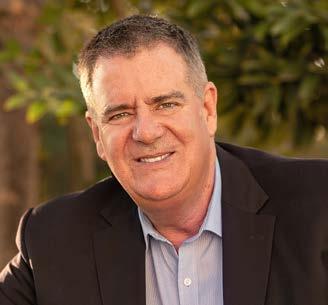
It was the Palaszczuk Government that first called for the Federal Government on 30 October last year to work with Queensland on a smaller version of the Bradfield Scheme.
Any Bradfield-style scheme starts with water storage in the north – and that’s underway. There’s three business cases underway or in hand into major water infrastructure in the north – into raising Burdekin Falls Dam, into Hells Gate Dam and Big Rocks Weir.
Urannah Dam has been declared a coordinated project to reduce red tape. The COVID-19 pandemic posed immediate challenges for agricultural supply chains, and that’s why Queensland was the first in the nation to declare agriculture an essential industry. That meant the logistical challenges, from the ability to freight goods and equipment across borders to arrangements for safely hiring workers, were front of mind and we met the challenge with unprecedented close cooperation with industry. This included regular meetings with a 70-strong Agriculture Coordination Group, which Canegrowers were important contributors to. We have put in place important industry recovery measures, including Market Diversification and Resilience grants, to help producers pivot to new markets. We have continued to acknowledge and support the important role that the sugar industry plays in our state, including with $2.85m in research support. Agriculture will continue to be a significant player as we implement Queensland’s $8 billion plan for economic recovery. If elected, what would your government do on these issues of great importance to Queensland’s cane-growing communities?
High electricity prices for irrigators:
We have tasked the Queensland Competition Authority with releasing new tariffs for regional Queensland. Tariff 34 is a new control load tariff that could see regional businesses like irrigators save up to 35 per cent when they come off an existing obsolete tariff.
High water prices:
We will continue a one-year irrigation price freeze. That means thousands of Queensland farmers will see their irrigation water prices remain the same or fall next year.
Industry red/green tape:
As part of Queensland’s $8 billion economic recovery plan we are streamlining planning requirements to make it easier for businesses, industries and communities by simplifying or removing a number of planning requirements.
Supporting industry best practice:
The Government will continue to work with industry to ensure sustainable practices into the future.
We have continued to support industry through initiatives such as the Rural Economic Development Grants program, and continuing the annual $100m investment in PIPES loans to support diversification and industry growth.

The LNP has an ambitious plan to stimulate the economy, create a decade of secure jobs and drag Queensland out of this recession. And backing farmers and boosting agriculture is at the heart of our plan to get Queensland working again.
The LNP supports Queensland farmers and canegrowers and we are determined to unlock this state’s agricultural potential. Queensland needs new leadership that understands regional Queensland, has policies that help farmers and is focused on creating secure jobs throughout the agricultural supply chain. The LNP’s plan will make sure Queensland gets the basics right, like reducing input costs and regulatory burdens and growing both domestic and export markets so we can unleash our agriculture.
The LNP backs the drought-busting New Bradfield Scheme, as well as the proposed Nullinga Dam, Urannah Dam, Emu Swamp Dam, Rookwood Weir and the Burdekin Falls Dam upgrade. We’ll fix the Paradise Dam too.
As well as building more water infrastructure, the LNP will also slash the price of water for SunWater irrigators by almost 20%.
Labor’s plan for water is non-existent. Annastacia Palaszczuk has no plan to provide the long-term infrastructure and structural reform farmers need to ensure they will have access to affordable water. The LNP also understands that the electricity prices paid by farmers and irrigators need to be reduced.
That is why we have the already announced regional electricity retail competition to slash electricity bills. We will continue to rollout policies that provide cheaper electricity for our farmers as well.
Our economic plan also includes a nonew-tax guarantee to give all businesses the confidence to invest and create jobs. In relation to red and green tape, an LNP Government will review and reform Queensland’s landscape management laws to support more regional jobs and protect the state’s valuable eco-systems.
Deb Frecklington Leader of the Opposition
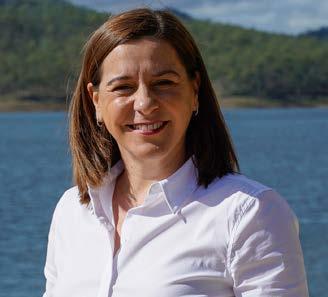
An LNP Government will commission a review into the Labor’s unfair vegetation management laws and launch the consultation process within its first 30 days, with the intention of delivering the review’s findings by mid-2021.
You also have our commitment that an incoming LNP Government will work with the agricultural sector and environmental groups to review and develop new environmental reef standards.
The LNP will ensure that changes to regulations will provide certainty, respect privacy and rely on sound agronomic science.
It’s time to stop Labor’s ideological attack on farmers and growers.
The LNP’s approach will be based on:
Improving water quality standards to protect the Great Barrier Reef
Protecting and securing our valuable agricultural sector
Legislating minimum standards
Respecting property rights
Incentivising best practices
The LNP is determined to work in partnership with our key industries, instead of throwing hurdles in their path like Labor has. That’s the only way we can build a stronger economy.
And a stronger economy is essential to ensure that Queensland can invest more in roads, dams, hospitals and schools for our rural and regional communities.
Only the LNP has a plan to secure Queensland’s future for the generation.
Only an LNP Government will get Queensland working again. If elected, what would your government do on these issues of great importance to Queensland’s cane-growing communities?
High electricity prices for irrigators:
The LNP understands that Labor’s current irrigation tariff regime is failing farmers and will have more to say about providing cheaper electricity over the coming weeks. The LNP has already announced regional electricity retail competition, which will slash the average household bill by an average of $300 a year.
High water prices:
An LNP Government will slash the price of water for more than 5,000 SunWater irrigators by almost 20% by implementing Queensland Competition Authority recommendations on financing asset renewals.
Industry red/green tape:
The LNP is committed to cutting and streamlining red and green tape so farmers can grow more local food and fibre. Our commitment includes reviewing Labor’s unfair reef regulations and vegetation management laws.
Supporting industry best practice:
The LNP has a proud record of supporting and funding the industry’s Smartcane BMP – something an incoming LNP government will continue.
The LNP is committed to working with growers, mills and all local cane communities to consider options for industry diversification and biomanufacturing opportunities.
Robbie Katter (Member for Traeger)

Katter's Australian Party, unlike the major parties does more than just talk and has delivered to cane growers throughout the state with unwavering commitment. We plan to continue with this track record post-election, and are running strong candidates in key cane-growing regions such as Shane Knuth MP in Hill, Nick Dametto MP in Hinchinbrook, Ciaron Paterson in Whitsundays, Attila FeherHolan in Mulgrave, Sam Cox in Burdekin and Paul Hudson in Burnett.
The KAP forced the introduction of the Ethanol and other Biofuels Mandate Amendment Bill and our Private Member’s Bill; the Sugar Industry (Real Choice in Marketing) Amendment Bill 2015, which ensures that a grower has real choice in terms of nominating the marketing entity for on-supply sugar in which they have an economic interest.
The Bill also facilitated the fair and final resolution of any commercial disputes that arise between a grower or bargaining representative and a mill owner including by arbitration. The KAP has also made the following commitments publicly should we secure the balance of power after the 2020 Queensland Election:
A 25% reduction in 2020/21 to 2023/24 water prices to grow and sustain the sugar industry. Introduce the KAP's Private Member’s Environmental and Other Legislation (Reversal of Great Barrier Reef Protection Measures) Amendment Bill. This Bill will repeal Labor’s farmdestroying reef runoff regulations in the next term of parliament in order to avoid the cane industry suffering a $1.3 billion loss over the next decade.
• Repeal the Vegetation
Management and Other Legislation Amendment Bill 2018 which again demonises c a n e g r o w e r s t h r o u g h introduction of draconian, costly and unnecessary regulatory requirements.
Steve Andrews (Member for Mirani)
One Nation acknowledges that Australian cane farmers are committed to evolving best practices and are environmental stewards of their land.
Excessive layers of regulation that have put farming under state control and One Nation will work immediately to remove these layers to return the practice of farming to be under farmers’ control. All our farming industries need complete confidence in the quality of science used for policy development and One Nation is fully committed to an Office of Scientific Integrity and Quality Assurance which will scrutinise the quality of science. We will immediately work to repeal the current intrusive and destructive Reef Regulations legislation as the claimed science has been shown to be inaccurate.
Cane farmers need assurances of a sustainable reduction in electricity costs. We propose to immediately introduce a low price Food & Fibre electricity tariff for farmers and food processors available until a new HELE coal-fired power station is built for affordable and reliable base load power. Water infrastructure is central to all farming and building dams is a key One Nation policy. We fully support projects such as Urannah, Rookwood Weir and Hells Gate and the associated irrigation pipelines. Our commitment is to provide affordable water to our Australian farmers and to prevent water being sold to overseas interests. Ensuring dams contain a hydro element addresses both water and electricity affordability. To restore our cane industry’s momentum the R&D supporting our cane farmers needs to be coordinated so all farmers quickly benefit from the latest technology and trials while ensuring money is used responsibly.
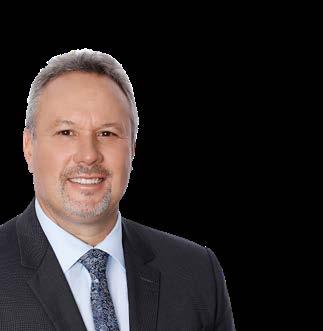
Michael Berkman (Member for Maiwar)
Queensland politics has been captured by big corporations. They make generous donations to Labor and the LNP, and get an easy ride in return. The Greens don’t take any corporate donations, so we’ll fight for you. Our COVID-19 recovery plan , funded by making sure mining companies, big banks and property developers pay their fair share, would create 78,000 good, secure jobs every year. We would: Fully fund our hospitals , especially in regional Queensland. This means 6,500 more nurses and 3,000 more doctors to cut elective surgery waiting lists.
Give every community access to a bulkbilling GP, with 200 totally free public health centres across the regions and the cities.
Fully fund public education , reducing class sizes and making state schools genuinely free by abolishing fees. This means new schools for regional Queensland and 6,000 new teachers.
We will cut power bills by 46% by stopping the price-gouging and profit-seeking by Stateowned energy companies like Ergon, Powerlink, Stanwell and CS Energy. The best way to cut power bills for irrigators and households is to stop privatisation and build 100% clean energy by 2030 that is publicly owned. Public ownership means we can take advantage of Queensland’s cheap, abundant wind and solar power. We have a plan to revive Queensland manufacturing , which would support cane growers to diversify into bio-manufacturing. Our plan would create a Queensland Manufacturing Authority with $1 billion to provide grants and cheap loans to clean manufacturing projects. The Greens support improving water quality and Best Management Practice. We also support strong, binding regulations to protect the Great Barrier Reef and make sure growers doing the right thing are not undercut by less scrupulous competitors. The Greens support increased funding to tackle pests and biosecurity threats that hurt cane growers and the environment.

AS MARKETING DEADLINE LOOMS
growers question Shared Pool expectations

by Warren Males Head - Economics CANEGROWERS
Most growers will be considering their selection of marketer for the 2021 season. Elections for sugar that has not yet been committed are due by the end of October. Ahead of this decision, several growers have asked why marketers are expecting such a wide range of Shared Pool results for this season.
In some years, the costs in the Shared Pool are higher that the revenues and the shared pool is a net expense on overall sugar returns. This year, things look positive, and the Shared Pool is likely to make one of the highest net positive contributions to sugar returns on record.
Some marketers are already reporting that they expect the Shared Pool to add around AUD200/t, IPS to their pool results. Across the industry, the improved Shared Pool results will add almost A$100 million of extra revenue to industry income. It certainly justifies CANEGROWERS' efforts to ensure sugar formed part of important trade agreements in recent years, improving access for Australian raw sugar into premium Far East markets such as South Korea, Indonesia and Japan. Let’s take a look at how the Shared Pool works and shine a light on why different marketers are reporting different results. In general terms, leaving aside the marketer’s ICE11 raw sugar pooling and price risk management activities, Shared Pools contain all the revenues and costs associated with the storage, handling and selling of raw sugar.
When the revenues exceed the costs, the net amount is added to the weighted average gross price the grower receives. Conversely, when shared costs exceed revenues, the amount is deducted from the grower’s gross price. It is important to note that although there may be differences in the way marketers report this information, all the various elements of shared revenues and costs do make their way to the cane price. When comparing reported Shared Pool prices, it is important for growers to understand the items different marketers include in their Shared Pool and the tonnage against which the Shared Pool is calculated. These differences are important. A good place to start is to understand the size of tonnage in your marketer’s Shared Pool.
Most marketers base their Shared Pool on the total volume marketed. When the Shared Pool is calculated across all tonnage, the amount is simply added to or subtracted from the grower’s gross price. In Mackay, a different approach is taken. QCS calculates its Shared Pool on the basis of its US Quota tonnage, around 3%, of the total sugar produced. The potential range for revenue components is outlined in Figure 1:
1. FOB Premium: relates to the physical premium arising from raw sugar sales made in Asia, often referred to as the Far East Premium. It moves up or down in response to the regional supply and demand situation and differences in freight rates. For 2020 season, the expected lower Thai crop has reduced the supply in the region and sales premiums available to Australia exporters are higher than usual.
2. US Quota: some marketers (MSF Sugar and QCS) include their net US Quota sales revenue as part of the Shared Pool, while others (QSL and Wilmar) manage and report their net US Quota revenue in separate pools. When treated as a Shared Pool item, the US Quota premium (the difference between the net FOB sugar market price in the Far East and the net FOB US sugar price (No.16 US raw sugar price less freight, duty and other costs), is added to the Shared Pool. The US quota premium, currently more than AUD410/t, when averaged across a
marketer’s whole tonnage contributes around A$4-5 per tonne to the average Shared Pool return. As noted, the Shared Pool calculation base for QCS uses is different to that used by other marketers.
Loyalty/Other Bonus: some marketers offer their grower customers bonuses for longer term commitments or volume commitments for their marketing services.
The potential range of costs that may be included in the Shared Pool is outlined in Figure 2.
Financing Costs: to enable cane advance payments to be made before the associated sugar has been physically shipped and paid for by customers, all marketers incur financing costs. Reflecting lower interest rates, interest costs on borrowings are now lower than in the last few years. It is important to note that some marketers (for example, Wilmar) do not include financing costs as part of their Shared Pool and report this as a separate expense.
Marketing Services Costs: all marketers incur costs in marketing and in providing marketing services to growers. These costs are recovered through a charge to the Shared Pool.
Pricing Platform Costs: some marketers provide online pricing platforms for growers to be able to use in managing their individual pricing orders and for other marketing activities. Others use manual systems. Whether online or manual, the associated costs are charged to the Shared Pool.
Storage and Handling: charges are passed on to the marketer by STL. Because different bulk sugar terminals have different cost structures (fixed and variable), marketers face an average cost base that reflects the bulk sugar terminal or terminals they use to store and ship their MEI and GEI raw sugar. The GEI portion of these costs is charged to the Shared Pool. FIG. 1
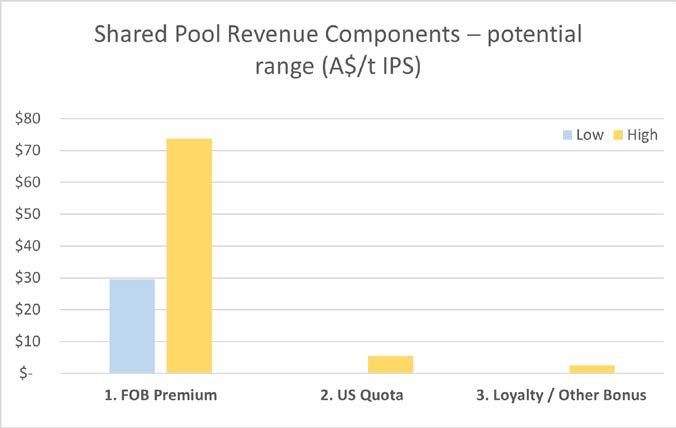
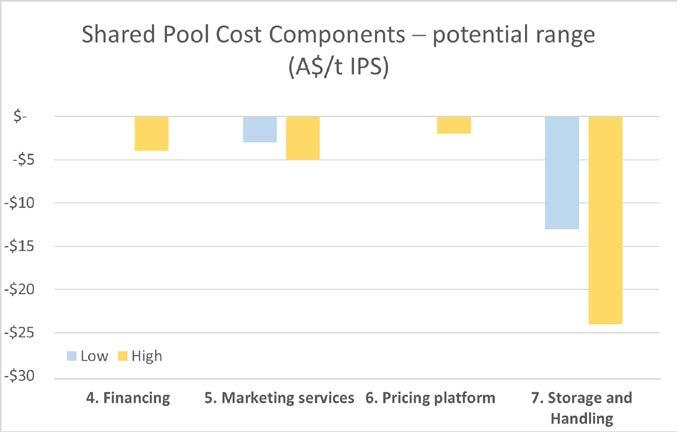
FIG. 2
Pictured: At almost 6km long, the jetty at Lucinda Bulk Sugar Terminal is the world's longest bulk sugar loading jetty. Storage and handling costs are covered by the Shared Pool.
